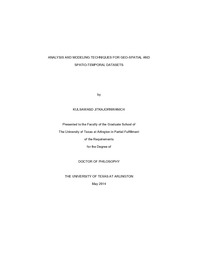
ATTENTION: The works hosted here are being migrated to a new repository that will consolidate resources, improve discoverability, and better show UTA's research impact on the global community. We will update authors as the migration progresses. Please see MavMatrix for more information.
Show simple item record
| dc.contributor.author | Jitkajornwanich, Kulsawasd | |
| dc.date.accessioned | 2017-05-31T19:22:33Z | |
| dc.date.available | 2017-05-31T19:22:33Z | |
| dc.date.submitted | January 2014 | |
| dc.identifier.other | DISS-12631 | |
| dc.identifier.uri | http://hdl.handle.net/10106/26676 | |
| dc.description.abstract | In recent years, spatio-temporal data has received a lot of attention and increasingly plays an important role in our everyday lives as we can witness from the fast-growing mobile technologies and its location-based application development. By spatio-temporal data, we mean data that is associated with specific spatial locations that change over time. For example, a cellphone or car with GPS will generate the object location at regular time intervals. Another example would be the track of a storm center as it moves. Spatio-temporal data could be thought of as a huge data warehouse, which contains hidden and meaningful information. However, to analyze the available spatio-temporal data directly from its original formats and locations is not easy because the data is often in a format that is difficult to analyze and is usually 'big'. Our research goals focus on spatio-temporal datasets and how to summarize, model, and conceptualize them for analysis and mining. Four main parts of this dissertation include: 1) spatio-temporal knowledge representation, 2) identifying meaningful concepts from raw data, 3) converting raw data to conceptual data, and 4) analysis and mining of conceptual data. In the first part of the dissertation, we look at the spatio-temporal datasets in general by considering spatio-temporal data semantics using techniques similar to those utilized in "Semantic Web". We work towards creating a spatio-temporal ontology framework, which can be used to represent and reason about spatio-temporal data. In the remaining parts, we focus on the spatio-temporal datasets in a specific domain, which is rainfall precipitation data in the hydrology domain. However, the techniques and methodology that we use can be adapted to different types of hydrological data such as soil moisture, water level, etc., as well as other types of big spatio-temporal data. Therefore, we propose a generalized framework for analyzing and mining big data in any given domain. The framework allows big data in a particular domain to be conceptually analyzed and mined by using ontologies and EER. | |
| dc.description.sponsorship | Elmasri, Ramez | |
| dc.language.iso | en | |
| dc.publisher | Computer Science & Engineering | |
| dc.title | Analysis And Modeling Techniques For Geo-spatial And Spatio-temporal Datasets | |
| dc.type | Ph.D. | |
| dc.contributor.committeeChair | Elmasri, Ramez | |
| dc.degree.department | Computer Science & Engineering | |
| dc.degree.discipline | Computer Science & Engineering | |
| dc.degree.grantor | University of Texas at Arlington | |
| dc.degree.level | doctoral | |
| dc.degree.name | Ph.D. | |
Files in this item
- Name:
- Jitkajornwanich_uta_2502D_12631.pdf
- Size:
- 3.910Mb
- Format:
- PDF
This item appears in the following Collection(s)
Show simple item record


